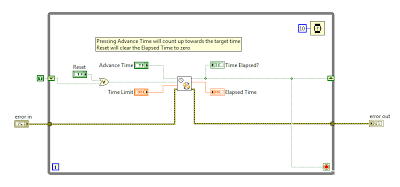After working through the example programs from National Instruments, I found that most of them have a common trait. Since I have worked through the programs twice and seem to have an understanding of the architecture that I plan on using, that might all change later today – story for another day, I am focusing on getting set pieces of code together that I can generate quickly to save time.
One of the very important functions that I have been practicing is a Timing Engine. This Timing Engine needs to be able to be Started, Stopped, Paused, Reset, have a Target Time set, indicate whether the timer Has Elapsed and indicate the running Elapsed Time.
Here is my main program that I used to test my Timing Engine. It starts off by resetting the Timing Engine and setting a Target Time. It will then run until the Target Time has been reached at which time the Time Elapsed? indicator will be set. The Timing Engine can be paused by clearing the Advance Time control and reset by pressing the Reset control.
The actual Timing Engine looks like this. (I got the idea from one of the example programs so this is not entirely my own work.) I like the way it works and can be put together really quickly so works well for me.
Basically, a time stamp is taken each time the vi is run. The previous time stamp is subtracted from the current time stamp giving the change in time (dt). If the Advance Time control is set, dt is added to the Elapsed Time and if the Reset control is set the Elapsed Time is set to zero. Once the Elapsed Time reaches the Target Time, the indicator is set.
I have used this Timing Engine for the Car Wash, Sprinkler Controller and Boiler Controller and it works really well. There are many other ways to perform this same task, but this works for me and I hope it can help you in some way.
Greg

